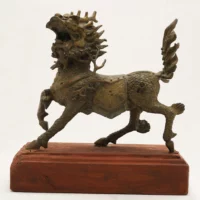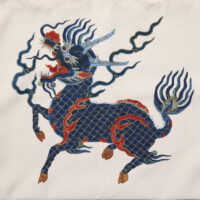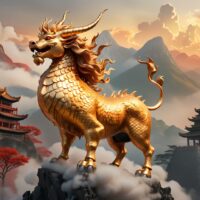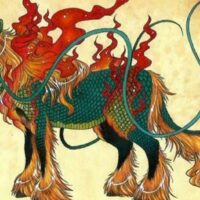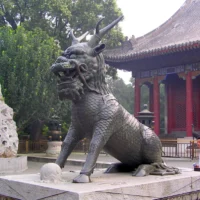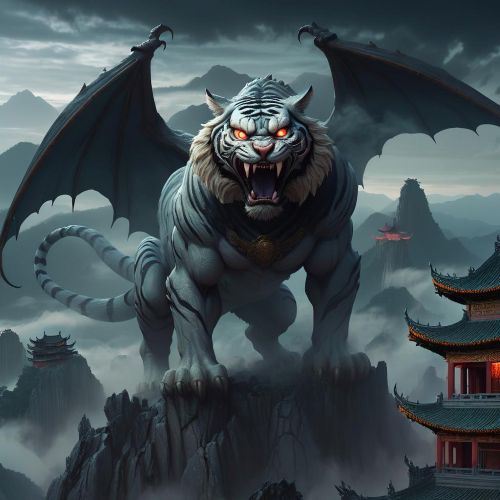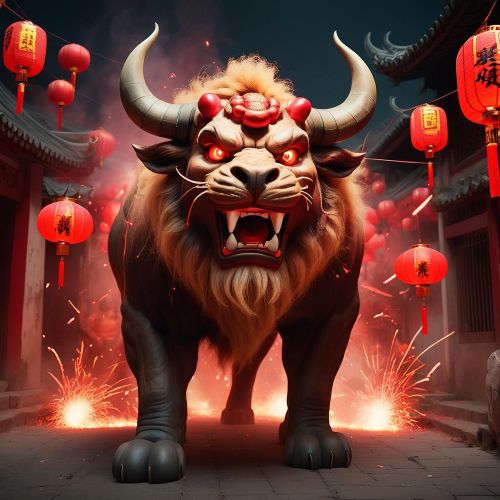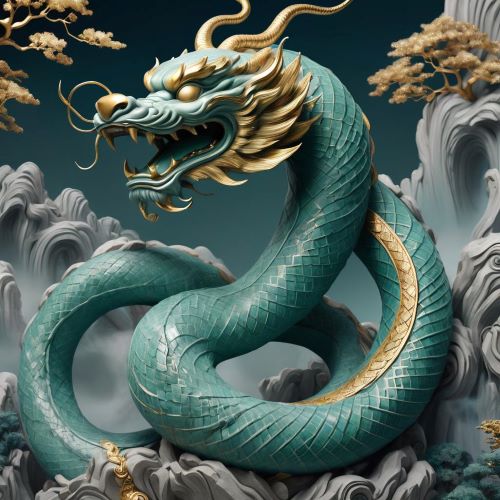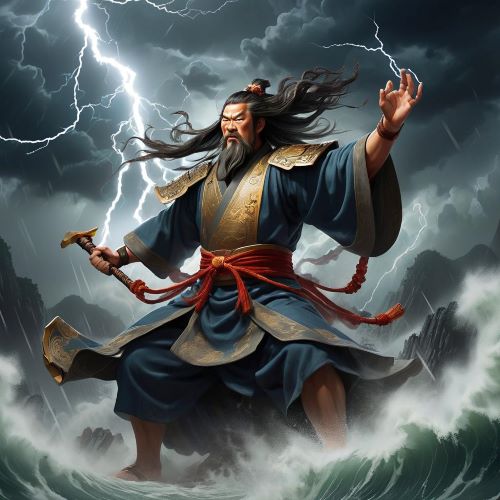Qilin : The Chinese Unicorn
Listen
At a glance
| Description | |
|---|---|
| Origin | Chinese Mythology |
| Classification | Hybrids |
| Family Members | N/A |
| Region | China |
| Associated With | Benevolence, Flight |
Qilin
Introduction
The Qilin (麒麟), often translated as the “Chinese unicorn,” is a mythical creature revered across East Asian traditions. Unlike its Western counterpart, the Qilin is not simply a beast of fantasy but a profound cultural symbol representing peace, virtue, and cosmic balance. In Chinese mythology, it is counted among the Four Auspicious Beasts, alongside the dragon, phoenix, and tortoise, each embodying essential aspects of prosperity and harmony. The Qilin’s appearance has long been associated with the reign of just rulers and the birth of great sages, marking it as a harbinger of heavenly approval. Ancient records describe its presence during the lifetime of Confucius, and over the centuries, the Qilin has transcended borders, finding a place in the mythologies of Korea, Japan, Vietnam, and beyond.
Physical Traits
The Qilin’s form is a fascinating fusion of features borrowed from various animals, reflecting its supernatural status. Typically, it is imagined with the graceful body of a deer or horse, but its surface is covered in glittering scales reminiscent of dragons or fish. Its head often takes on a dragon-like shape, though some depictions liken it to a lion, wolf, or ox, depending on regional influences. A defining element of the Qilin is its horns—sometimes a single backward-curving horn, other times a pair, reinforcing why it is frequently, though not always accurately, compared to the unicorn.
Other physical markers add to its celestial aura. Its mane flows upward as though caught in an eternal breeze, its beard shines like fire, and its hooves resemble those of a deer, split and delicate. Flames or glowing clouds frequently surround its body, symbolizing its divine essence. While golden depictions are the most common, Qilin can appear in a spectrum of radiant colors—emerald, crimson, jade, or jewel-like combinations. During the Ming dynasty, artists inspired by exotic giraffes brought back from Africa often gave Qilin long necks, weaving real-world encounters into its evolving imagery. Despite its formidable appearance, the Qilin is said to tread so lightly that it leaves grass unbent beneath its feet, underscoring its gentle and benevolent nature.
Family
Within Chinese cosmology, the Qilin belongs to the illustrious group of mythological guardians known as the Four Auspicious Beasts. Each represents a domain of creation: the dragon rules over aquatic creatures, the phoenix presides over birds, the tortoise commands shelled beings, and the Qilin stands as the master of land-dwelling animals. Collectively, they embody a balanced universe shaped by wisdom, longevity, power, and prosperity.
Legends also trace the Qilin’s ancestry to dragons, with some stories claiming it descended from Yinglong, the winged dragon of Chinese lore. Other traditions suggest it was born from a union of celestial beings and earthly animals, making it both divine and terrestrial in essence. Because of its association with creation myths, it is sometimes said that the Qilin accompanied Pangu, the primordial giant, during the shaping of the heavens and earth. This mythological lineage places the Qilin at the heart of cosmic order, a sacred being that embodies both balance and moral authority.
Other names
The Qilin has traveled widely across cultures, and with each migration, it has taken on new names and slightly different appearances. In Chinese, the term itself is a combination of qi (male) and lin (female), though either can be used to describe the species as a whole.
In Japan, it is called Kirin, often portrayed as a deer-like creature with a dragon’s head, flowing mane, and sometimes an ox’s tail. The Japanese also use the same word “Kirin” for giraffes, a legacy of Ming dynasty encounters with the animal.
In Korea, it is known as Girin (기린). Korean depictions initially emphasized its resemblance to deer, but over time it came to look more horse-like, with manes and features that shifted according to local artistic traditions. Much like in Japan, the modern Korean language also uses “girin” to refer to giraffes.
In Thailand, the creature is called Gilen and belongs to the mythical Himapant forest pantheon, where it is seen as a hybrid embodying elemental magic. In Vietnam, it is referred to as Kỳ Lân, where it holds a similar reputation as a bringer of fortune and a symbol of nobility. These regional variations highlight the Qilin’s adaptability as a cultural archetype, capable of absorbing local beliefs while maintaining its central role as a celestial protector.
Powers and Abilities
Although fierce in appearance, the Qilin is celebrated for its benevolence and extraordinary restraint. Legends say it avoids harming any living creature and can walk across grass without bending the blades. Its supernatural powers, however, are vast and awe-inspiring.
The Qilin is most famous as a harbinger of auspicious events. Its arrival foretells the birth of sages or signals the presence of just rulers. A popular story recounts how a Qilin appeared before the birth of Confucius, presenting his mother with a jade tablet inscribed with the destiny of her unborn child. Similarly, it is believed to emerge at the death of great souls, affirming their divine status.
The Qilin also possesses the ability of moral discernment. It is said to bow before those pure of heart while punishing the corrupt. Though normally peaceful, it can unleash devastating power against the wicked, sometimes incinerating them with divine fire. Its protective role extends to warding off evil spirits and ensuring safety wherever it resides.
Elemental powers are also attributed to the Qilin, with some traditions describing its control over storms, frost, and fire. Its breath is said to conjure flames or thunder, while in other tales it emits a cooling mist that brings fertility and peace. The Qilin thus embodies both creative and destructive forces, always guided by righteousness and compassion.
Beyond its magical abilities, the Qilin is a symbol of prosperity and righteousness, often representing talented individuals and noble deeds. It is not simply a beast of fantasy but a moral ideal, embodying the virtues that a just society should aspire to.
Modern Day Influence
The Qilin continues to play a powerful role in contemporary culture, bridging ancient mythology with modern life. Its enduring presence is evident in art, architecture, festivals, and even popular media.
In architecture and Feng Shui, Qilin statues are placed at the entrances of temples, government offices, and homes to attract prosperity and guard against misfortune. Feng Shui practitioners believe that positioning a pair of Qilin facing the entrance ensures wealth, luck, and protection for the household.
The Qilin dance, performed during major celebrations like Lunar New Year and weddings, is another living tradition. Dancers wear elaborate costumes, often with a single horn and brightly colored scales, and move gracefully to the rhythm of drums and cymbals. The performance symbolizes peace, prosperity, and the warding off of evil.
Historically, the Qilin was associated with imperial power and achievement. During the Qing dynasty, military officials of the highest rank wore robes embroidered with the Qilin, marking their elevated status. The creature’s prestige also extended to the Qilin Court, established in the Han dynasty, which celebrated outstanding ministers and generals.
Modern adaptations of the Qilin are abundant. In Japan, Kirin Brewery uses it as its logo, highlighting its association with trust and excellence. In Korea and Japan, the linguistic link between Qilin and giraffes continues, blending myth with zoology. The creature has also appeared in global popular culture, from anime and video games like Monster Hunter to Hollywood productions such as Fantastic Beasts: The Secrets of Dumbledore.
In education and technology, the Qilin’s symbolism has been reimagined as well. For example, language-learning chatbots named after the Qilin act as guides for students, echoing the creature’s role as a messenger of wisdom.
The Qilin remains more than a myth—it is a cultural emblem that evolves with every generation. Whether as a guardian in Feng Shui, a majestic figure in traditional festivals, or a mystical being in modern storytelling, the Qilin continues to symbolize peace, virtue, and divine harmony in the human imagination.
Related Images
Source
China Highlights. (2023). Qilin: The Chinese Unicorn. Retrieved August 19, 2025, from https://www.chinahighlights.com/travelguide/chinese-zodiac/qilin.htm
World History Encyclopedia. (2024). Qilin. Retrieved August 19, 2025, from https://www.worldhistory.org/Qilin/
New World Encyclopedia. (2023). Qilin. Retrieved August 19, 2025, from https://www.newworldencyclopedia.org/entry/Qilin
Ancient Origins. (2022). Qilin: The Mythical Chinese Beast That Heralds the Arrival of a Sage. Retrieved August 19, 2025, from https://www.ancient-origins.net/myths-legends-asia/qilin-0015974
Frequently Asked Questions
What is lorem Ipsum?
I am text block. Click edit button to change this text. Lorem ipsum dolor sit amet, consectetur adipiscing elit. Ut elit tellus, luctus nec ullamcorper mattis, pulvinar dapibus leo.
What is lorem Ipsum?
I am text block. Click edit button to change this text. Lorem ipsum dolor sit amet, consectetur adipiscing elit. Ut elit tellus, luctus nec ullamcorper mattis, pulvinar dapibus leo.
What is lorem Ipsum?
I am text block. Click edit button to change this text. Lorem ipsum dolor sit amet, consectetur adipiscing elit. Ut elit tellus, luctus nec ullamcorper mattis, pulvinar dapibus leo.
What is lorem Ipsum?
I am text block. Click edit button to change this text. Lorem ipsum dolor sit amet, consectetur adipiscing elit. Ut elit tellus, luctus nec ullamcorper mattis, pulvinar dapibus leo.
What is lorem Ipsum?
I am text block. Click edit button to change this text. Lorem ipsum dolor sit amet, consectetur adipiscing elit. Ut elit tellus, luctus nec ullamcorper mattis, pulvinar dapibus leo.


